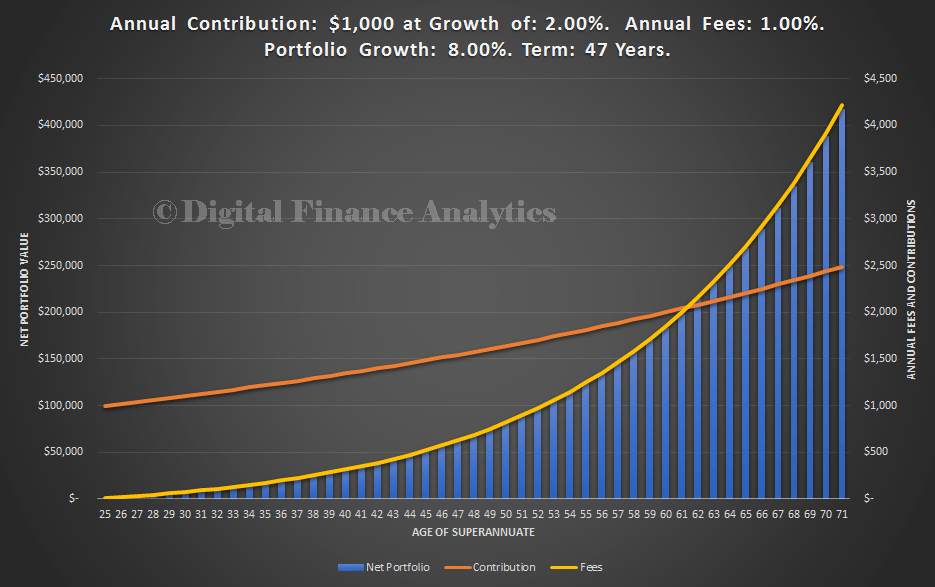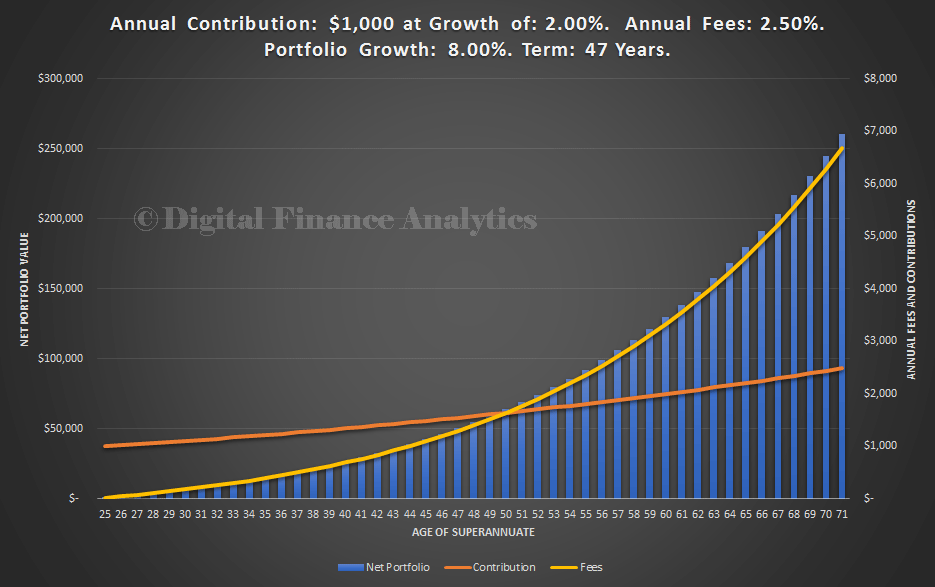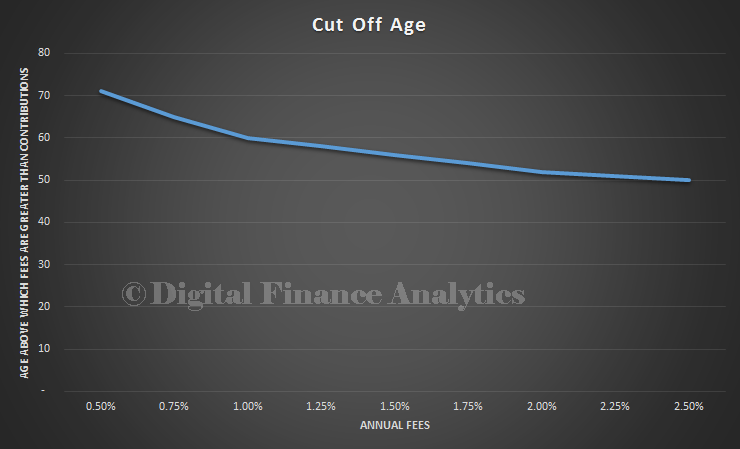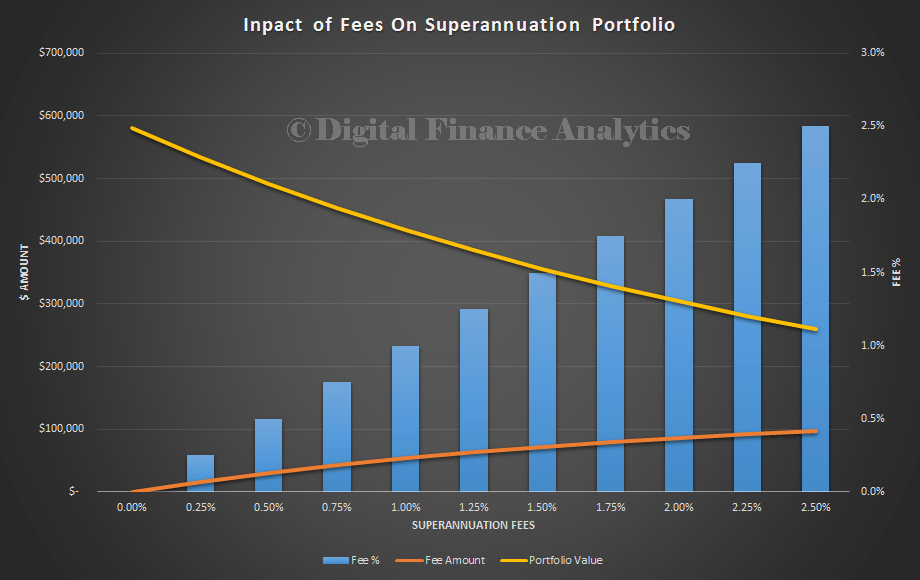
By Martin North. Cross Posted from Digital Finance Analytics Blog
Last week, we started our series on Superannuation, and showed that performance varied by type of fund, and across funds in an unpredictable way. Today we look at the industry from a consumer perspective. This is important because the overall returns as reported by APRA do not necessarily translate into the experience of individual superannuation accounts. This may be because of specific options selected in the enrollment process, but is most significantly impacted by the range of fees and charges taken from individual members each year.
There are a long list of fees which may be taken from a members account through the life of the fund. ASIC, at its moneysmart site lists more than 10 fees which may be charged, either as a % of the fund, or a fixed amount.
“Member fees – General administration fees to cover the cost of keeping your super account.
Management or investment management fees (also known as MER) – Fees for managing your investment which can vary for different investment options.
Contribution fees – Fees to cover the administration expense of receiving and investing your contributions.
Adviser service fees – Fees for personal advice provided about your super and other investments. Your adviser may also receive commissions for certain investments that they recommend to you.
Insurance premiums – The cost of insurance provided through your super fund. Many super funds have a set default insurance option. You can usually choose to lower or increase your level of cover based on your needs.
Establishment fees – an administration charge for setting up your account in the fund.
Withdrawal or termination fees – you may be charged fees when you take money out of your super account, for example when you retire or rollover to a different fund.
Investment switching fees – fees for changing investment options within your super account.
Contribution splitting fees – charged when you split off some of your contributions to your spouse’s super account.
Performance fees -additional fees that may be payable if your investments perform better than market benchmarks.
Issuer fees – fees charged by the investment issuer for overseeing the fund.
Expense recovery fees -out-of-pocket expenses your trustee is entitled to recover from your super account.
Family law split fee – fees charged to split your super following a separation and family law court order.”
The application of fees has a profound impact on the overall returns from the fund to a member, especially any fees which are applied to the balance of the fund. To illustrate this, DFA has built a set of scenarios to examine the impact of fees. We will make a series of assumptions, to assist the analysis. Lets assume a new investor starts to make $1,000 in the first year, aged 25, and increases contributions by 2% in each subsequent year. Lets assume the fund grows at 8% each year and that fees are 1% each year on the balance of the fund. In this scenario, by aged 71, (47 years in the fund) the value would be $425,000. Note, I have ignored tax issues in this analysis, to simplify things. The red line shows the contributions, the yellow line the fees, and the blue bars the net fund value each year.
 Now, lets change the fees charged to 2.5%. In this scenario, the fund will be worth only $253,000, if other parameters stay the same. A massive drop in value.
Now, lets change the fees charged to 2.5%. In this scenario, the fund will be worth only $253,000, if other parameters stay the same. A massive drop in value.
 We can run a series of scenarios, to illustrate just how volatile the returns are as fees change. With no fees, the portfolio would be worth nearly $600,000. As fees rise, the value falls significantly.
We can run a series of scenarios, to illustrate just how volatile the returns are as fees change. With no fees, the portfolio would be worth nearly $600,000. As fees rise, the value falls significantly.
The reason for the changes in outcomes is explained by the compounding effect in the fund. Looking at the 2.25% scenario, in the first year, the fund takes 2.25% from the $1,000 contribution. In the second year, it takes another 2.25% from that initial contribution, plus from any additional ones made, and from growth in the fund. And this continues for the life of the investment.
In fact, there will be a crossover point where any new contributions to the fund will be completely wiped out by fees. We modelled this, for our scenario. With fees at 1.5%, any contributions over 55 years old, will be eaten up in fees.

The larger the fund, the greater the fees. The higher the growth, the greater the fees. The higher the fees, the smaller the overall return. Its simple mathematics. In our next post on this subject, we will look at what the DFA household survey has to say about consumers awareness of their superannuation, and specifically about the fees paid.
But already, we begin to see why self managed superannuation is so attractive, as you can avoid most of the fees, and retain control of the investments, especially as balances grow.
It is not just in Australia that attention is being drawn to the fees on superannuation. In the UK in October 2013, the Government announced it would move towards legally capping fees at 0.75% or 1% and is in the midst of industry consultation as the the correct level, seeking to end what the Pension Minister called “excessive” fees.


